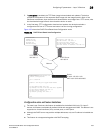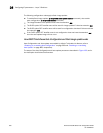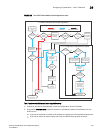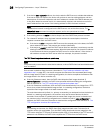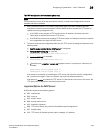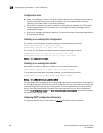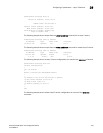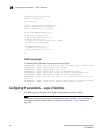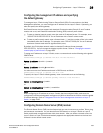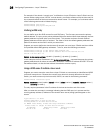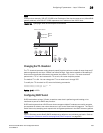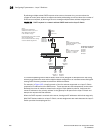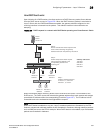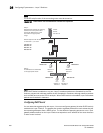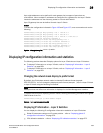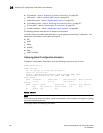
PowerConnect B-Series FCX Configuration Guide 863
53-1002266-01
Configuring IP parameters – Layer 2 Switches
26
Configuring the management IP address and specifying
the default gateway
To manage a Layer 2 Switch using Telnet or Secure Shell (SSH) CLI connections or the Web
Management Interface, you must configure an IP address for the Layer 2 Switch. Optionally, you
also can specify the default gateway.
Dell PowerConnect devices support both classical IP network masks (Class A, B, and C subnet
masks, and so on) and Classless Interdomain Routing (CIDR) network prefix masks:
• To enter a classical network mask, enter the mask in IP address format. For example, enter
“209.157.22.99 255.255.255.0” for an IP address with a Class-C subnet mask.
• To enter a prefix network mask, enter a forward slash ( / ) and the number of bits in the mask
immediately after the IP address. For example, enter “209.157.22.99/24” for an IP address
that has a network mask with 24 significant bits (ones).
By default, the CLI displays network masks in classical IP address format (example:
255.255.255.0). You can change the display to prefix format. Refer to “Changing the network
mask display to prefix format” on page 869.
To assign an IP address to a Layer 2 Switch, enter a command such as the following at the global
CONFIG level.
PowerConnect(config)# ip address 192.45.6.110 255.255.255.0
Syntax: ip address <ip-addr> <ip-mask>
or
Syntax: ip address <ip-addr>/<mask-bits>
You also can enter the IP address and mask in CIDR format, as follows.
PowerConnect(config)# ip address 192.45.6.1/24
To specify the Layer 2 Switch default gateway, enter a command such as the following.
PowerConnect(config)# ip default-gateway 192.45.6.1 255.255.255.0
Syntax: ip default-gateway <ip-addr>
or
Syntax: ip default-gateway <ip-addr>/<mask-bits>
NOTE
When configuring an IP address on a Layer 2 switch that has multiple VLANs, make sure the
configuration includes a designated management VLAN that identifies the VLAN to which the global
IP address belongs. Refer to “Designated VLAN for Telnet management sessions to a Layer 2
Switch” on page 1145.
Configuring Domain Name Server (DNS) resolver
The Domain Name Server (DNS) resolver feature lets you use a host name to perform Telnet, ping,
and traceroute commands. You can also define a DNS domain on a Layer 2 Switch or Layer 3
Switch and thereby recognize all hosts within that domain. After you define a domain name, the
Layer 2 Switch or Layer 3 Switch automatically appends the appropriate domain to the host and
forwards it to the domain name server.



